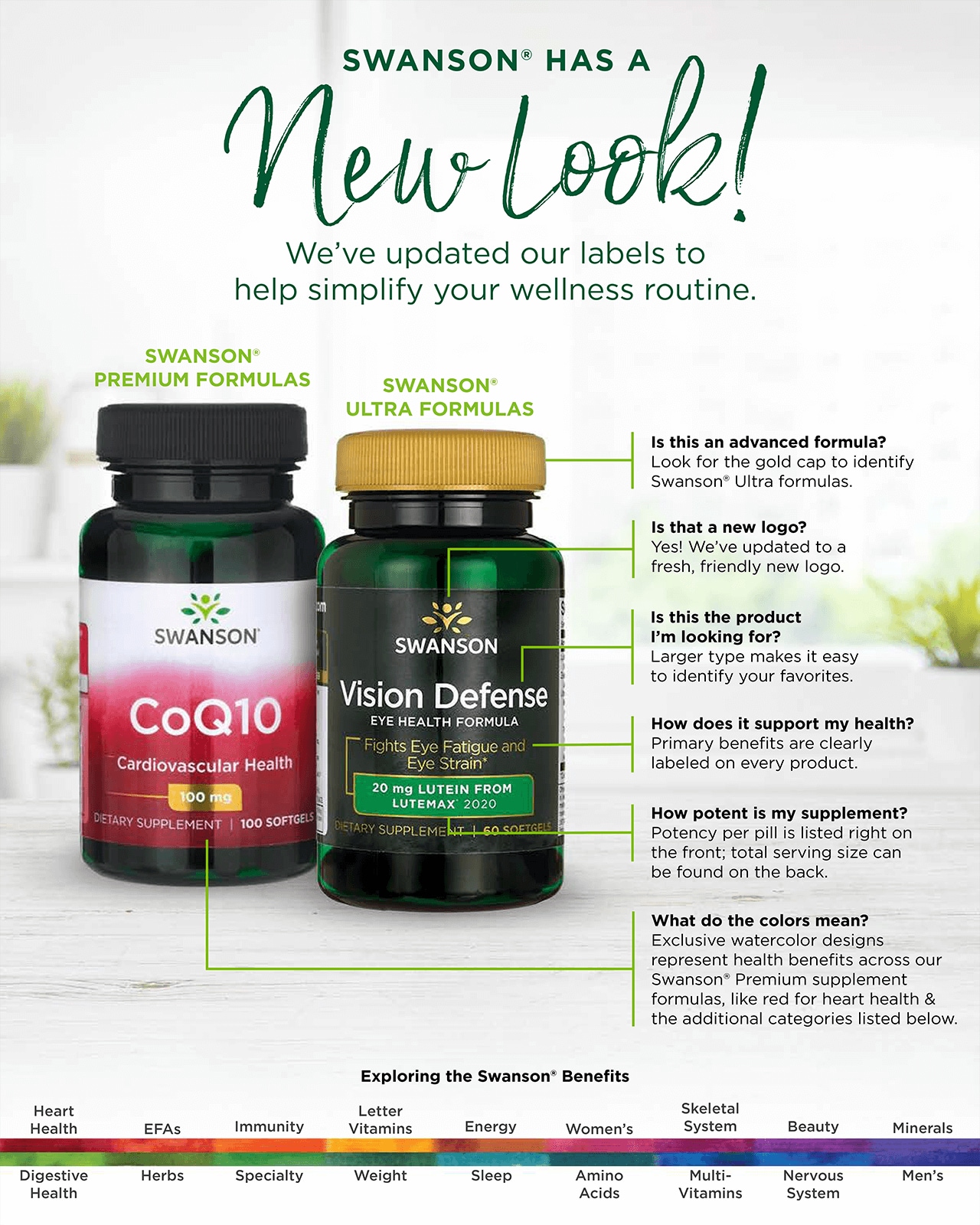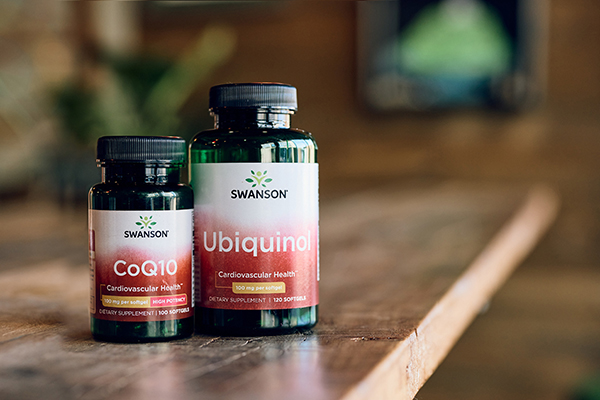Product labels answer a lot of important questions for wellness seekers, helping us understand exactly what we are consuming and how it meets our daily nutritional needs. But if you’ve looked at nutritional or supplement fact labels recently for certain products, you may have noticed a few changes.
Between 2016 and 2019, the Food and Drug Administration (FDA) introduced new guidelines that bring more clarity to sugar and fiber content, increase the Recommended Dietary Allowance (RDA) of vitamin D, and outlined several other important changes to the way products are labeled.
Although these changes have been on the horizon for a while, there was a grace period for actually making them, with a compliance deadline of January 2020 for larger companies and January 2021 for smaller companies. Many companies, including Swanson, began changing labels after the initial announcement, but because of the grace period new labels for some products are just starting to surface and will continue to do so over the next year. Here’s what you need to know about these changes, plus a helpful visual chart from the FDA.
Total Sugars vs. Added Sugars
Previously, if a product contained sugar of any kind, the label simply indicated the amount it contained. For example, if a product contained 3 grams of sugar, the label would read: Sugars 3g. The problem with this system was that some foods—such as fruits—contain sugar naturally. It’s helpful to know when the sugar you’re consuming is added vs. naturally-occurring so you can make choices that fit your nutritional goals.
Under the new guidelines, the full amount of sugar in a product from all sources will be listed as “Total Sugars” on the label, with a smaller listing below it detailing “Added Sugars.” This way, you get a clearer picture of how much added sugar you’re consuming vs. sugar that occurs naturally in the product’s ingredients.1
Labels on single-ingredient, natural sweetener products like pure honey, pure maple syrup and other pure syrups like agave are not required to bear the words “Includes Added Sugars” but must still include the DV percentage for added sugars. Although these natural pantry staples have no added refined sugar within them, the use of these ingredients still equates to added sugars in your diet. The amount of added sugars those ingredients contribute to your diet will be listed on the label along with a † symbol leading the reader to smaller text clarifying that while the ingredient adds sugar to your diet, the product contains no added sugar.2
For tips on swapping out refined sugar in your diet for healthier natural sweeteners or calorie-free options, check out How to Replace Sugar with Healthier Sugar Alternatives.
Redefining Dietary Fiber
Just as some foods contain natural sugar and others contain added sugar, certain foods contain natural fiber and others contain added fiber. Added fiber can either be a naturally-occurring fiber that has been isolated from its original source, or synthetic fiber.
In the past, nutritional labels have basically counted all types of fiber equally, but since added fibers may or may not impart the same wellness benefits as natural fiber the FDA has taken steps to bring clarity to this area as well, and the recommended daily value (DV) of fiber has increased slightly from 25 grams to 28 grams.3
The new guidelines specify that in order to be included in the total grams of fiber listed on a nutritional label, the fiber included must offer proven physiological benefits. That’s good news for those of us craving the blood-sugar supporting, gut-balancing, satiating goodness of wholesome fiber.
Here are the types of fiber that can be included in the total fiber count.
- Beta-glucan: a type of soluble fiber from oats
- Psyllium husk: a mostly-soluble seed husk fiber from the Plantago ovata plant
- Cellulose: an insoluble fiber from plant cell walls and vegetables fibers
- Guar gum: soluble fiber extracted from guar beans
- Pectin: soluble fiber from the cell walls of fruits and vegetables
- Locust bean gum: soluble fiber from carob seeds
- Hydroxypropylmethylcellulose: an insoluble fiber made by modifying cellulose, often used in gluten-free products
Based on FDA’s review of the science behind these fibers, FDA intends to propose that the following non-digestible carbohydrates be added to the definition of dietary fiber.
- Mixed plant cell wall fibers: fiber made up of two or more plant cell wall fibers
- Arabinoxylan: fiber from the primary and secondary plant cell walls of wood and cereal grains
- Alginate: fiber from the cell walls of brown algae
- Inulin and inulin-type fructans: fiber from chicory root, which has a prebiotic effect in the gut helping feed good gut flora
- High amylose starch (resistant starch 2): a type of starch from potatoes or cereal grains like wheat, corn and rice barley
- Galactooligosaccharide: another type of prebiotic fiber found in beans, root vegetables and dairy products
- Polydextrose: synthetic fiber made by combing dextrose from corn with citric acid and sugar alcohol
- Resistant maltodextrin/dextrin: a type of hydrolyzed starch from corn, wheat or potatoes
- Cross-linked phosphorylated RS4: modified starch that can be made from a variety of plant sources, including wheat
Important Changes for Vitamin D
Vitamin D is more important than you may realize, and unfortunately most people don’t get enough. Without it, your body can’t absorb the calcium you need to keep bones and teeth strong. It also plays a role in immune function, supporting a healthy mood, modulating cell growth and much more.
In 2016, the Food and Nutrition Board increased the RDA of vitamin D for most adults from 400 IU (10 mcg) to 600 IU (15 mcg) per day, and 800 IU (20 mcg) for ages 70+.1
Some doctors and nutritionists still recommend higher daily vitamin D intakes, especially for those at risk for having low levels. The Vitamin D Council, an organization dedicated to raising awareness about vitamin D, recommends average adults supplement with 5,000 IU (125 mcg) of vitamin D daily. Talk with your doctor about your individual needs.
Vitamin D Measurements: Micrograms vs. International Units
In addition, vitamin D amounts must now be listed in micrograms (mcg) on supplement facts and nutrition labels instead of international units (IU). Given that IU was a widely-established and recognized form of measurement for vitamin D, during the transition period companies may include both mcg and IU on product labels for clarity.1
If you want to convert vitamin D IU to mcg, simply divide the IU number by 40 to get the equivalent mcg, or to convert mcg to IU, simply multiply the mcg number by 40.
Example:
1,000 IU = 25 mcg, since 1,000 ÷ 40 = 25
20 mcg = 800 IU, since 20 × 40 = 800
Did My Vitamin D Supplement Change?
If you take a vitamin D supplement regularly, during the transition you may have noticed that the daily value percentage on your usual supplement was suddenly lower, which may have led you to believe the product changed.
Take a closer look at your product label to be sure, but most likely the amount of vitamin D in the product didn’t change at all. The same product simply fulfills a lower percentage of the RDA than it did prior to the change because the RDA is now higher.
Want to learn more about vitamin D, why you need it and how to get the vitamin D you need each day? Read Say Hello to the Sunshine Vitamin.
Daily Value Changes for Other Nutrients
In addition to the increase in recommended daily amounts of fiber and vitamin D mentioned above, the DV for the below nutrients have changed for most adults due to updated nutrition science research.4
Daily Value Increases
- Vitamin C: increased from 60 mg to 90 mg
- Vitamin K: increased from 80 mcg to 120 mcg
- Magnesium: increased from 400 mg to 420 mg
- Manganese: increased from 2 mg to 2.3 mg
- Phosphorus: increased from 1,000 mg to 1,250 mg
- Potassium: increased from 3,500 mg to 4,700 mg
- Calcium: increased from 1,000 mg to 1,300 mg
Daily Value Decreases
- Vitamin B-12: decreased from 6 mcg to 2.5 mcg
- Vitamin B-6: decreased from 2 mg to 1.7 mg
- Biotin: decreased from 300 mcg to 30 mg
- Niacin: decreased from 20 mg to 16 mg
- Chromium: decreased from 120 mcg to 35 mcg
- Chloride: decreased from 3,400 mg to 2,300 mg
- Copper: decreased from 2 mg to 0.9 mg
- Molybdenum: decreased from 75 mcg to 45 mcg
- Zinc: decreased from 15 mg to 11 mg
- Thiamin: decreased from 1.5 mg to 1.2 mg
- Riboflavin: decreased from 1.7 mg to 1.3 mg
- Pantothenic acid: decreased from 10 mg to 5 mg
Newly-Established Daily Value for Choline
Previously, no daily value had been established for choline. Choline was acknowledged as a nutrient in 1998, much later than other required nutrients. Your body makes some choline on its own but you still need to get the majority of choline from your diet. It’s essential for many processes in the body, from cellular structure and messaging to metabolizing fat and promoting nervous system health. It also assists vitamin B12 and folate with functions related to DNA synthesis.5
The newly-established daily value for choline is 500 mg per day. You can get it from choline supplements or foods including eggs (113 mg of choline per egg), beef liver (290 mg of choline per 2.4 ounces), chicken liver (222 mg of choline per 2.4 ounces), cod (249 mg per 85 grams), and more.5
Folic Acid Supplement Daily Value
Research shows that 70% more folate is absorbed from folic acid supplements than from foods that contain folate, so folic acid supplement labels will be updated to reflect this finding and better align with the dietary folate equivalent. A supplement providing 400 mcg of folic acid previously would have indicated it fulfills 100% of your DV requirements, however now that same 400 mcg supplement will be labeled as fulfilling 170% of your daily requirement.5
Additional Labeling Changes
In addition to the above, here are some other changes you may notice on product labels.
Calorie Updates
- Calories are now displayed much larger, so it is more prominent on the label
- Calories from fat are no longer listed separately on nutritional labels since experts have agreed that some fats are healthy
Nutrient Labeling Updates
- The list of vitamins and minerals that are of public health significance have been updated, which impacts the nutrients that must be listed on a product label—for example, vitamin D and potassium declarations are now required on product labels the FDA feels most people don’t get the recommended amounts. Vitamins A and C are no longer required to be listed since the FDA feels deficiencies of these vitamins are rare today.
- Certain reference values used to calculate the daily value percentage of nutrients has changed to more realistically reflect serving sizes commonly consumed (see more under Serving Size Changes below).
- The footnote listing the reference values for certain nutrients for 2,000 and 2,500 calorie diets has changed. Calorie needs of each individual can vary greatly, so the footnote will now read “*The % Daily Value tells you how much a nutrient in a serving of food contributes to a daily diet. 2,000 calories a day is used for general nutrition advice.”
- The maintenance of records to support the listing of certain nutrients on labels under specified circumstances is required, meaning manufacturers must keep written records to verify declarations of dietary fiber, added sugars, vitamin E, folate and folic acid in food products.
Serving Size Changes
- The definition of a single-serving container has changed to more realistically reflect what a person is likely to consume in one sitting, such as a full can of soda.
- Dual-column nutritional labels are now required for some packaging, which means that some larger packages that are likely to be consumed in one sitting must be labeled with both per serving and per package nutritional information.
- Several reference amounts that are used by manufacturers to determine their label serving size have changed to more closely reflect what people realistically consume—like an entire muffin vs. only half or a third of a muffin.
You can find more information about the label changes plus answers to frequently asked questions on the U.S. Food & Drug Administration website.
Swanson Health Products Labels
At Swanson, our healthy obsession with total wellness means we strive to go above and beyond. We acted on the new guidelines much earlier than required and began updating our labels in 2017. But as your #1 trusted source for quality wellness products and expertise, we’re sharing this information to help you understand changes you may have already noticed or will soon see on labels for both food products and supplements.
We've also updated our labels with an exciting new look and simple to read format, making it easier than ever for you to distinguish between our premium formulas, potencies, and quickly identify how a supplement supports your health. Here's a guide to our new look below!
If you found this article helpful, you may also like Don’t Let Nutrition Labels Scare You and Pack Your Pantry: How to Make a Real Food Pantry.

About Lindsey Toth, MS, RD
Registered Dietitian, Swanson Health Products
Lindsey is a nationally-recognized registered dietitian and nutritionist with a soft spot for pie. She empowers people to take charge of their health by finding the balance between the pleasure and nourishment in food.
Her philosophy is that you should take care of your body because it’s the only permanent home you have. It’s what inspired her to pursue a career in nutrition and, ultimately, led her to Swanson Health Products.
Sources
1 Nutrition and Supplement Facts Labels: Questions and Answers Related to the Compliance Date, Added Sugars, and Declaration of Quantitative Amounts of Vitamins and Minerals: Guidance for Industry. U.S. Department of Health and Human Services. Food and Drug Administration. Center for Food Safety and Applied Nutrition. https://www.fda.gov/media/117402/download
2 The Declaration of Added Sugars on Honey, Maple Syrup, Other SingleIngredient Sugars and Syrups, and Certain Cranberry Products: Guidance for Industry. U.S. Department of Health and Human Services. Food and Drug Administration. Center for Food Safety and Applied Nutrition. https://www.fda.gov/media/127928/download
3 The Declaration of Certain Isolated or Synthetic Non-Digestible Carbohydrates as Dietary Fiber on Nutrition and Supplement Facts Labels: Guidance for Industry. U.S. Department of Health and Human Services. Food and Drug Administration. Center for Food Safety and Applied Nutrition. https://www.fda.gov/media/113663/download
4 ConsumerLab.com Helps Consumers Make Sense of the FDA’s Updated Daily Values (DV) for Vitamins and Minerals. ConsumerLab.com. https://www.consumerlab.com/news/updated-daily-values-vitamins-minerals/07-27-2016/
5 What is Choline? Healthline. https://www.healthline.com/nutrition/what-is-choline






